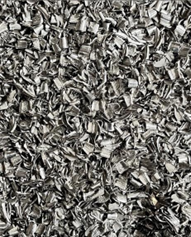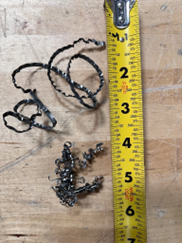When it comes to suppressing Class D fires, there’s no playbook — especially if you’re trying to do it better than anyone else.
Class D metals like zirconium, magnesium and titanium burn at temperatures up to 7000° F, can emit toxic fumes and, if the flame is exposed to water, can split H2O molecules into separate fire-feeding oxygen and explosive hydrogen, further amping up the danger.
So, when Firetrace set out to design a new pre-engineered local application system for Class D fires, we knew we’d have to build our own rules, run our own tests, and push our own limits. After more than 100 Class D fire suppression tests, we walked away with experience, insight and the most efficient Class D fire suppression system on the market.
Testing 100 Fires: The Challenges



As expected, not all metal chips behave the same when ignited.
Swarf ignited more readily, burned more intensely, and produced larger, more aggressive flames — demanding rapid and comprehensive suppression. In contrast, standard chips burned more slowly but retained heat longer, making containment much more challenging.
Coolant types added another layer of complexity. Fires involving chips cut dry, with oil, or with water-based coolants each displayed distinct characteristics, further influencing how the fires spread and how they could be controlled.
These differences underscored just how challenging it is to design a suppression system that can perform reliably across the full spectrum of real-world machine shop conditions.
[Class D Drum Test - Zirconium metal chips (swarf) - Oil coolant present]
The interplay between chip type, cutting method, and individual shop practices made consistency in suppression a complex engineering challenge.
These observations helped us refine our new Class D fire suppression system’s core parameters to be inclusive of fire behaviors from both a variety of chips and various microenvironments, not solely inside a CNC machine. We were able to better understand the limitations of our system, allowing us to answer questions such as how much area one nozzle could cover, how deep the fire could be and still be suppressed, and how much agent was truly necessary to consistently suppress the fire.
Reaching System Limits — and Redesigning Around Them
One of the key takeaways from the testing was that dry powder fire suppression isn’t just about how much agent you use — it’s also about how you apply it. This was especially true for the drum application. In early tests, our standard Class D nozzle performed beautifully in the CNC machine cutting zone, but fell short in the collection drum tests, where fires could vary in height, depending on the amount of metal turning collected inside the drum
We saw inconsistent coverage throughout different depths inside the drum and limited penetration, resulting in incomplete suppression. This led to 1) better defining what we meant by "suppression", and 2) a nozzle redesign that adhered to this new definition, providing proper coverage at any depth inside of the drum.
The Challenges with Collection Drum
 What made the collection drum particularly difficult to protect from a Class D fire was the varying height of the chips inside the drum. Unlike the cutting zone, the drum’s depth and seemingly "empty" space created a surprising flow effect upon system activation. When discharging into the drum, the powder was deflected by the air already in the drum, resulting in inconsistent coverage.
What made the collection drum particularly difficult to protect from a Class D fire was the varying height of the chips inside the drum. Unlike the cutting zone, the drum’s depth and seemingly "empty" space created a surprising flow effect upon system activation. When discharging into the drum, the powder was deflected by the air already in the drum, resulting in inconsistent coverage.
This inconsistency led us to rethink both the nozzle’s geometry and the flow characteristics. We needed a nozzle that could deliver wider, more even coverage at varying heights, with slower discharge velocity to ensure the agent settled into the drum rather than being pushed out by a turbulent flow.  After redesigning and testing a new nozzle specifically for drum applications—with larger orifices, and wider shrouds for a lower mounting position—we achieved reliable suppression even in near-empty or full-drum conditions.
After redesigning and testing a new nozzle specifically for drum applications—with larger orifices, and wider shrouds for a lower mounting position—we achieved reliable suppression even in near-empty or full-drum conditions.
Results From Testing
Through our rigorous system limitations testing, we discovered a smarter way to fight Class D fires. We were able to:
- Use up to 4x less agent than competitors
- Better understand the limits of system coverage.
- Create a system that works in multiple fire environments, from open machining zones to confined chip collection drums.
And perhaps most importantly, we set our own standards. As Luis Ruiz, Project Engineer II stated, “There are no standardized protocols for testing Class D fire suppression systems. We had to leverage relevant standards (NFPA 17 and UL 711) and build our own”.
As the saying goes, “innovation precedes standards”, and this was one of those cases.
The Outcome of The Effort
Firetrace’s approach to Class D suppression is grounded in firsthand insight. We didn’t guess. We tested. We iterated. We learned. And in doing so, we were able to deliver a system that’s not only effective — it’s efficient, targeted, and smartly designed.
Our system is the most efficient Class D fire suppression system on the market.
It’s the result of understanding what really works — and why.
And that’s what happens when you let observation lead innovation.
